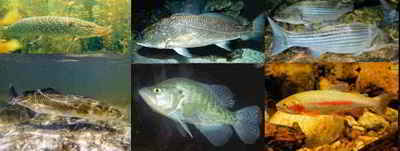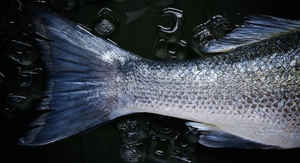Iowa Un-Official State Fish
Channel Catfish

(Ictalurus punctatus)
Adopted: (Un-official)
It isn't quite official, but this whiskered water wonder just might take it's place on Iowa's State symbols list. The Iowa Senate voted (48-0) and
now it's up to the Iowa House to make it so.
For several years George Marzeck, a retired West Burlington man, fought to get the catfish into legislation. A retired writer and artist, Marzeck passed
away last September.
So what makes this fish so special? As one of America's most numerous catfish species, the Channel Catfish can grow to weigh around 40 lbs. Most notably,
catfish have whisker like sensory organs called barbels around their mouths- giving them the "cat" in their name. What makes them an Iowa
favorite?
A sponsor of the bill, Senator Amanda Ragan, stated in the The Ames Tribune, that it's because "The channel catfish was here when the pioneers
arrived to settle the state and is still found in all 99 counties." Ragan isn't the only one who wanted the catfish to be official though.
Iowa Un-Official State Fish: Channel Catfish

Channel catfish closely resemble blue catfish. Both have deeply forked tails. However, channels have a rounded anal fin with 24-29 rays and scattered black spots along their back and sides. They have a small, narrow head. Channel catfish have eight barbels (whiskers). The back is blue-gray with light blue to silvery-gray sides and a white belly. Larger channels lose the black spots and also take on a blue-black coloration on the back which shades to white on the belly. Males also become very dark during spawning season and develop a thickened pad on their head.
Common Names
Spotted cat, blue channel cat, fiddler, river catfish, great lakes catfish, lady cat
Characteristics of the Channel Catfish
Subspecies
There are no recognized subspecies. However, on rare occasions, they hybridize with blue and flathead catfish. Aquaculturists recognize numerous hatchery stocks and create a variety of hybrids to improve their culture characteristics.
Range
Channel catfish inhabit deep streams, rivers, and lakes in eastern and central US, especially in deep stretches of sand, gravel, or rubble bottom. They also inhabit lakes, reservoirs, and ponds. The preferred water temperature is 75-80 °F.
Habitat
Most common in big rivers and streams. Prefers some current, and deep water with sand, gravel or rubble bottoms. Channel catfish also inhabit lakes, reservoirs and ponds. They adapt well in standing water where stocked.Channel Catfish occur throughout the Mississippi River Valley, and down to the Mexico border. Channel Catfish are the most commonly raised aquaculture species in the US
Spawning Habits
Spawning occurs mostly in rivers and streams in the spring and early summer when waters warm to 70 to 85 degrees. They also will spawn in larger lakes where suitable habitat is available. Eggs are deposited in nests secluded under banks or logs or over open bottom. The male selects the site, often a natural cavern or hole, clears the nest and guards the eggs and young. A female may lay 2,000 to 21,000 eggs that hatch in six to 10 days depending on water temperature. Males protect the fry until they leave the nest in about a week.
Feeding Habits
Feeds primarily at night using taste buds in the sensitive barbels and throughout the skin to locate prey. Although they normally feed on the bottom, channels also will feed at the surface and at mid-depth. Channel catfish feed on insect larvae, clams, snails, crayfish, crabs, and aquatic plants. They locate food by probing the bottom with their barbels. Small channels consume invertebrates, but larger ones may eat fish.
Age and Growth
Maximum size attained is about 20 pounds. The fish's weight generally averages two to four pounds. Studies indicate 11 years as the maximum age, but some fish probably live 15 to 20 years.
Length: Up to 24 inches
Weight: Up to 20 pounds
Life span: Up to 11 years
Iowa Senate Joint Resolution 2001
Senate Joint Resolution 2001
* Bill Introduced: S.J. 44
* Complete Bill History
Sec. 1. STATE FISH DESIGNATED. The channel catfish (ictalurus punctatus) is designated and shall be officially known as the state fish of Iowa.
Sec. 2. APPROPRIATE REPRESENTATIONS. The director of the department of cultural affairs shall obtain appropriate pictures and other representations
of the channel catfish and shall display the pictures and representations in an appropriate place in the state historical museum.
Sec. 3. OFFICIAL REGISTER. The editor of the Iowa Official Register shall include an appropriate picture and commentary of the channel catfish
in the Iowa Official Register, along with the pictures of the state rock, state flower, state bird, and state tree.
EXPLANATION
This joint resolution designates the channel catfish as the official state fish of Iowa. The director of the department of cultural affairs shall obtain
pictures and other appropriate representations of the state fish and display the pictures and information in the state historical museum. The editor
of the Iowa Official Register shall include a picture of the state fish along with pictures of the state rock, state bird, state tree, and state flower.
Action
Jan. 11 00
Resolution filed, under Rule 28. S.J. 44.
Jan. 11 00
Referred to State Government. S.J. 45.
Jan. 12 00
Subcommittee, Fink, Schuerer and Sexton. S.J. 56.
Taxonomic Hierarchy: Channel Catfish
Kingdom: Animalia - animals
Phylum: Chordata - chordates
Subphylum: Vertebrata - vertebrates
Class: Osteichthyes
Subclass: Actinopterygii
Order: Siluriformes
Suborder: Siluroidei
Family: Ictaluridae
Genus: Ictalurus
Species: Ictalurus punctatus








